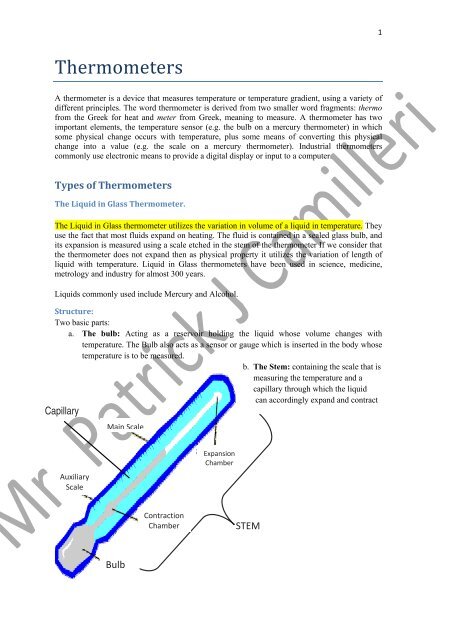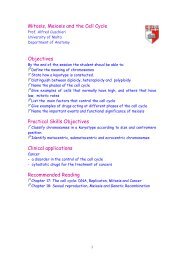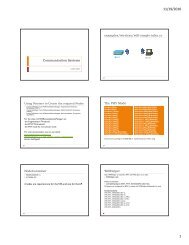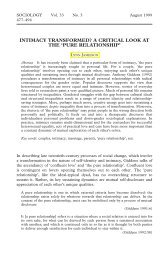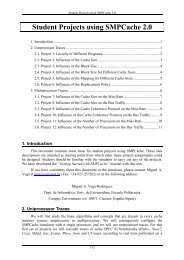Types of Thermometers
Types of Thermometers
Types of Thermometers
Create successful ePaper yourself
Turn your PDF publications into a flip-book with our unique Google optimized e-Paper software.
<strong>Thermometers</strong><br />
A thermometer is a device that measures temperature or temperature gradient, using a variety <strong>of</strong><br />
different principles. The word thermometer is derived from two smaller word fragments: thermo<br />
from the Greek for heat and meter from Greek, meaning to measure. A thermometer has two<br />
important elements, the temperature sensor (e.g. the bulb on a mercury thermometer) in which<br />
some physical change occurs with temperature, plus some means <strong>of</strong> converting this physical<br />
change into a value (e.g. the scale on a mercury thermometer). Industrial thermometers<br />
commonly use electronic means to provide a digital display or input to a computer.<br />
<strong>Types</strong> <strong>of</strong> <strong>Thermometers</strong><br />
The Liquid in Glass Thermometer.<br />
The Liquid in Glass thermometer utilizes the variation in volume <strong>of</strong> a liquid in temperature. They<br />
use the fact that most fluids expand on heating. The fluid is contained in a sealed glass bulb, and<br />
its expansion is measured using a scale etched in the stem <strong>of</strong> the thermometer If we consider that<br />
the thermometer does not expand then as physical property it utilizes the variation <strong>of</strong> length <strong>of</strong><br />
liquid with temperature. Liquid in Glass thermometers have been used in science, medicine,<br />
metrology and industry for almost 300 years.<br />
Liquids commonly used include Mercury and Alcohol.<br />
Structure:<br />
Two basic parts:<br />
a. The bulb: Acting as a reservoir holding the liquid whose volume changes with<br />
temperature. The Bulb also acts as a sensor or gauge which is inserted in the body whose<br />
temperature is to be measured.<br />
b. The Stem: containing the scale that is<br />
measuring the temperature and a<br />
capillary through which the liquid<br />
can accordingly expand and contract<br />
Capillary<br />
Auxiliary<br />
Scale<br />
Main Scale<br />
Bulb<br />
Contraction<br />
Chamber<br />
Expansion<br />
Chamber<br />
STEM<br />
1
General Properties<br />
Advantages:<br />
1. They are cheap to manufacture<br />
2. Easy to carry and handle.<br />
Disadvantages:<br />
1. They tend to have high heat capacities. They are not sensitive enough, that is they cannot<br />
measure rapid temperature changes.<br />
The mercuryinglass thermometer:<br />
Invented by German physicist Daniel Gabriel Fahrenheit, is a thermometer consisting <strong>of</strong> mercury<br />
in a glass tube. Calibrated marks on the tube allow the temperature to be read by the length <strong>of</strong> the<br />
mercury within the tube, which varies according to the temperature. To increase the sensitivity,<br />
there is usually a bulb <strong>of</strong> mercury at the end <strong>of</strong> the thermometer which contains most <strong>of</strong> the<br />
mercury; expansion and contraction <strong>of</strong> this volume <strong>of</strong> mercury is then amplified in the much<br />
narrower bore <strong>of</strong> the tube. The space above the mercury may be filled with nitrogen or it may be<br />
a vacuum.<br />
Range: Covering a wide temperature range from -38 °C to 356 °C, although the introduction <strong>of</strong> a<br />
gas into the instrument<br />
can increase the range to 600 °C or beyond.<br />
Advantages:<br />
1. Mercury is a naturally opaque liquid (Silver). This means that it can be directly utilised in<br />
its pure form<br />
2. Mercury does not wet glass. When it moves up and down in the capillary strong cohesive<br />
properties <strong>of</strong> mercury do not allow it to leave any traces on the inside <strong>of</strong> the capillary.<br />
3. Mercury is a liquid metal. As a metal it has high conductive properties that allow it to be<br />
more sensitive<br />
than the alcohol in glass thermometer.<br />
Disadvantages:<br />
1. Mercury poses a potential toxic hazard if the glass container is ruptured.<br />
The alcoholinglass thermometer:<br />
As a liquid it utilises ethyl alcohol, toluene and technical pentane, which can be used down to<br />
-200 °C.<br />
Range c. -200 °C to 80°C, though range tends to be highly dependent on the type <strong>of</strong> alcohol used.<br />
Advantages:<br />
1. It can measure<br />
very low temperatures.<br />
Disadvantages:<br />
1. Alcohol is transparent therefore it requires a dye to make it visible. Dyes tend to add<br />
impurities that may not have the same temperature range as the alcohol making reading<br />
difficult especially at the limits <strong>of</strong> each liquid.<br />
2
2. Alcohol wets glass.<br />
General Equation for Temperature calculation using a liquid in glass thermometer:<br />
LΘ - L0<br />
Θ = X 100<br />
L100- L0<br />
The resistance thermometer<br />
Makes use <strong>of</strong> the change <strong>of</strong> resistance in a metal wire with temperature. As electrons move<br />
through a metal, they are impeded by the thermal vibrations <strong>of</strong> the atoms in the crystal lattice. The<br />
higher the temperature the greater the impediment to flow thus the higher the resistance. This<br />
effect is very marked in pure metals, and for a well-behaved material enables measurements <strong>of</strong><br />
temperature to be made to better than 0.001 °C.<br />
Usually platinum wire is used in the construction <strong>of</strong> the thermometer, since it is a noble metal<br />
which is un-reactive over a wide range <strong>of</strong> temperatures. But copper, nickel and rhodium alloy<br />
may also be used in various temperature ranges. Usually a coil <strong>of</strong> the pure wire is wound onto an<br />
alumina former or placed in the bores <strong>of</strong> an alumina tube, and this assembly is mounted in a steel<br />
tube.<br />
Resistance thermometers are slowly replacing thermocouples in many lower temperature<br />
industrial applications (below 600°C). Resistance thermometers come in a number <strong>of</strong><br />
construction forms and <strong>of</strong>fer greater stability, accuracy and repeatability. The resistance tends to<br />
be almost linear with temperature. A small power source is required.<br />
No special extension cables or cold junction compensations are required. The resistance <strong>of</strong> a<br />
conductor is related to its temperature. Platinum is usually used due to its stability with<br />
temperature. The Platinum detecting wire needs to be kept free <strong>of</strong> contamination to remain stable.<br />
A Platinum wire or film is created and supported on a former in such a way that it gets minimal<br />
differential expansion or other strains from its former, yet is reasonably resistant to vibration.<br />
Resistance thermometers require a small current to be passed through in order to determine the<br />
resistance. This can cause self heating and manufacturers limits should always be followed along<br />
with heat path considerations in design. Care should also be taken to avoid any strains on the<br />
resistance thermometer in its application.<br />
Resistance thermometers elements are available in a number <strong>of</strong> forms. The most common are:<br />
Wire Wound in a ceramic insulator - High temperatures to 850 °C<br />
Wires encapsulated in glass - Resists the highest vibration and <strong>of</strong>fers most protection to the Pt<br />
Thin film with Pt film on a ceramic substrate - Inexpensive mass production<br />
3
Practical Construction<br />
Advantages<br />
1. Depending on the metal being used resistance thermometers are able to cover extensive<br />
temperature ranges. Maximum values are generally related to the melting points <strong>of</strong> the<br />
metal used.<br />
2. Variation <strong>of</strong> resistance with temperature is stable over an extensive temperature range.<br />
3. Very accurate<br />
Disadvantages<br />
1. Compared to liquid in glass thermometers, they tend to be expensive.<br />
2. Require other equipment to measure temperature.<br />
3. They exhibit high heat capacities thus they are not sensitive to temperature change<br />
meaning that they cannot be used to measure rapid temperature changes.<br />
RΘ - R0<br />
Θ = X 100<br />
R100- R0<br />
Thermocouples<br />
As a Thermometric property thermocouples<br />
utilise the variation <strong>of</strong> EMF generated at a bimetallic<br />
junction with temperature.<br />
In 1821, the German-Estonian physicist<br />
Thomas Johann Seebeck discovered that<br />
when any conductor (such as a metal) is subjected to a thermal gradient, it will generate a<br />
voltage. This is now known as the thermoelectric effect or Seebeck<br />
effect.<br />
4
The Seeebeck<br />
effectt:<br />
when a coonductor<br />
is placed in a temperaturee<br />
gradient, eelectrons<br />
dif ffuse<br />
along thhe<br />
gradient annd<br />
an emf, or<br />
thermovolttage,<br />
is gener rated. The mmagnitude<br />
<strong>of</strong> the emf depe ends<br />
on the mmaterial<br />
andd<br />
also on its physical coondition.<br />
To measure thee<br />
generated thermal emf f (or<br />
Seebeckk<br />
emf), the ciircuit<br />
must bbe<br />
completedd<br />
using a seco ond differentt<br />
conductor. This is joine ed to<br />
the first conductor att<br />
the point <strong>of</strong>f<br />
measuremeent<br />
and passe es through the<br />
same tempperature<br />
grad dient,<br />
forming a thermocouple.<br />
The thermocoupple<br />
emf is then the difference<br />
bettween<br />
the emfs e<br />
generateed<br />
in the two conductors.<br />
Any atteempt<br />
to meaasure<br />
this vooltage<br />
necesssarily<br />
involv ves connectinng<br />
another cconductor<br />
to o the<br />
"hot" ennd.<br />
This addditional<br />
condductor<br />
will tthen<br />
also ex xperience the<br />
temperature<br />
gradient, and<br />
develop a voltage <strong>of</strong><br />
its own whhich<br />
will opppose<br />
the ori iginal. Fortunnately,<br />
the mmagnitude<br />
<strong>of</strong> f the<br />
effect deepends<br />
on thhe<br />
metal in uuse.<br />
Using a dissimilar metal m to commplete<br />
the cirrcuit<br />
will ha ave a<br />
differentt<br />
voltage gennerated,<br />
leavving<br />
a small difference voltage<br />
availaable<br />
for measurement,<br />
which w<br />
increasees<br />
with temperature.<br />
Thiss<br />
difference can typically y be betweenn<br />
1 and abouut<br />
70 microv volts<br />
per degrree<br />
Celsius ffor<br />
the modeern<br />
range <strong>of</strong> available metal m combinaations.<br />
Certaain<br />
combinat tions<br />
have become<br />
popular<br />
as industrry<br />
standardss,<br />
driven by cost, availaability,<br />
conveenience,<br />
mel lting<br />
point, chhemical<br />
propperties,<br />
stabillity,<br />
and outpput.<br />
It is immportant<br />
to nnote<br />
that theermocoupless<br />
measure th he temperatuure<br />
differencce<br />
between two<br />
points, nnot<br />
absolutee<br />
temperaturee.<br />
In traditioonal<br />
applica ations, one o<strong>of</strong><br />
the junctions<br />
— the cold<br />
junctionn<br />
— was maiintained<br />
at a known (refeerence)<br />
tempe erature, whille<br />
the other eend<br />
was attac ched<br />
to a proobe.In<br />
practice,<br />
thermocoouples<br />
have two junctio ons. One <strong>of</strong> the junctionns<br />
is held at t the<br />
temperatture,<br />
t1, to bee<br />
measured, ffor<br />
example in a furnace.<br />
The secondd<br />
reference juunction<br />
is held<br />
at<br />
temperatture<br />
t2 whichh<br />
is usually tthe<br />
melting ppoint<br />
<strong>of</strong> pure e ice. This caan<br />
be done wwith<br />
real mel lting<br />
ice.<br />
Typicall<br />
Thermocoouples<br />
5
Cold Junction<br />
METAL TYPE 1<br />
000<br />
METAL TYPE 2<br />
METAL TYPE 1<br />
Cold Reservoir Hot Reservoir<br />
Unknown temperature is found according to the relation:<br />
EΘ - E0<br />
Θ = X 100<br />
E100- E0<br />
6<br />
High Impedance millivolt meter<br />
Many different thermocouple combinations have been used, but only 8 are standardised. These<br />
include 3 noble metal thermocouples using platinum and platinum-rhodium alloys, widely used<br />
for temperature measurement up to 1600 °C. The remaining 5 mainly use nickel-based alloys,<br />
which are cheaper and more suitable for industrial use up to about 1200 °C. Other refractory<br />
alloys can be used up to and beyond 2000 °C.<br />
Advantages:<br />
1. Cheap to manufacture.<br />
2. The simplicity, ruggedness, low cost, small size and wide temperature range <strong>of</strong><br />
thermocouples make them the most common type <strong>of</strong> temperature sensor in industrial use.<br />
3. Low heat capacities making it capable <strong>of</strong> measuring rapid temperature changes.<br />
Disadvantages:<br />
1. Sensitivity reduces accuracy.<br />
Hot Junction
The Constant Volume Gas Thermometer<br />
As a thermometric property it uses the variation <strong>of</strong> pressure <strong>of</strong> a gas with temperature.<br />
Usually air is used as a gas. For better accuracy other gases like helium that tend to have very low<br />
melting points close to absolute zero are used.<br />
Advantages:<br />
1. It is very accurate. In fact its accuracy allows it to be utilised to calibrate other<br />
thermometers.<br />
Disadvantages:<br />
1. It is not easy to handle and read.<br />
2. It tends to be highly sensitive to temperature change, and mechanical vibrations. In fact<br />
to give a reading it usually entails a lot <strong>of</strong> time.<br />
3. Expensive to manufacture and keep.<br />
Radiation thermometry/Pyrometry<br />
PΘ - P0<br />
Θ = P100- P0<br />
Makes use <strong>of</strong> the fact that all objects emit<br />
radiation in the infrared and visible parts <strong>of</strong> the<br />
spectrum, the intensity <strong>of</strong> which varies strongly<br />
with temperature.<br />
X 100<br />
The radiation can be measured remotely, enabling measurements to be made <strong>of</strong> objects which are<br />
moving, very hot, in a hostile environment or rapidly changing in temperature, or in situations where<br />
contamination <strong>of</strong> a product must be avoided. The fundamental relationship governing thermally<br />
emitted radiation is the Planck law. This relates the intensity <strong>of</strong> the radiation from a perfect radiator<br />
(or blackbody) to the temperature and wavelength. Radiation thermometers gather and focus the<br />
thermal radiation onto a detector. Semiconductor detectors are usually used: the most common are<br />
Silicon, Lead Sulphide, Indium Antimonide or Indium Gallium Arsenide. The output can be easily<br />
digitised and continuously monitored. Radiation thermometry has long been used for measuring<br />
temperatures in industrial and manufacturing processes, and it is now being increasingly used to make<br />
measurements at more ordinary temperatures. However their apparent ease <strong>of</strong> use masks the equal<br />
ease with which they can be used incorrectly. Field-<strong>of</strong>-view effects, reflections, atmospheric<br />
absorption and unknown emissivity are all potential problems.<br />
7


